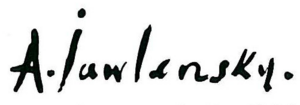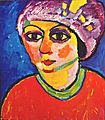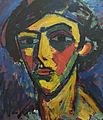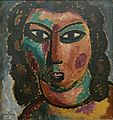Alexej von Jawlensky facts for kids
Quick facts for kids
Alexej von Jawlensky
|
|
|---|---|

Self-portrait, 1905
|
|
| Born | 13 March 1864 Torzhok, Tver Governorate, Russian Empire
|
| Died | 15 March 1941 (aged 77) Wiesbaden, Germany
|
| Nationality | Russian |
| Known for | Painting |
| Spouse(s) |
Helene Nesnakomoff
(m. 1922) |
Alexej Georgewitsch von Jawlensky (Russian: Алексе́й Гео́ргиевич Явле́нский) (born March 13, 1864 – died March 15, 1941) was a Russian painter. He is known for his unique style called Expressionism. He spent most of his artistic life in Germany. Alexej was an important member of several famous art groups, including the New Munich Artist's Association, Der Blaue Reiter (The Blue Rider), and later Die Blaue Vier (The Blue Four).
Contents
Discovering Art: Alexej's Early Life
Alexej von Jawlensky was born in Torzhok, a town in Russia. He was the fifth child in his family. When he was ten, his family moved to Moscow. After some military training, he became very interested in painting. Around 1880, he visited the Moscow World Exposition, which showed off many amazing things, including art.
Thanks to his connections, he was able to move to St. Petersburg. From 1889 to 1896, he studied at the art academy there. He did this while still serving in the military. Alexej became friends with Ilya Repin, a famous Russian painter. There, he met Marianne von Werefkin, who was also a wealthy artist. She became his mentor and helped him with his art career.
Becoming an Artist in Munich
In 1894, Jawlensky and Werefkin moved to Munich, Germany. He continued his art studies there. In 1905, Jawlensky visited another artist named Ferdinand Hodler. Two years later, he became good friends with Jan Verkade and met Paul Sérusier. These friends taught him about the art styles of the Nabis and Synthetist groups. These styles focused on using color and shape to express feelings.
In Munich, he also met Wassily Kandinsky and other Russian artists. Together, they helped create the New Munich Artist's Association. During this time, Jawlensky's paintings were full of bright, rich colors. Later, his style became more abstract and simple.
Between 1908 and 1910, Jawlensky and Werefkin spent summers in the Bavarian Alps. They were joined by Kandinsky and his artist friend Gabriele Münter. They painted the beautiful mountain landscapes. They also tried out each other's painting methods and talked about their art ideas. After a trip to the Baltic coast and meeting Henri Matisse and Emil Nolde, Jawlensky started using color and shape even more to show emotion in his portraits.
New Beginnings and Famous Series
In 1914, World War I began, and Alexej had to leave Germany. He moved to Switzerland. In 1916, he met Emmy Scheyer, another artist. She decided to focus on promoting his art in the United States.
After a break from painting people, Jawlensky created some of his most famous works. These include the Mystical Heads (1917–19) and the Saviour’s Faces (1918–20). These paintings remind people of the traditional Russian Orthodox icons he saw as a child.
In 1921, Alexej von Jawlensky returned to Germany and settled in Wiesbaden. In 1922, he married Hélène Nesnakomoff. She was the mother of his only son, Andreas, who was born in 1902.
In 1924, he formed the Blue Four art group. Their works were shown in Germany and the US, thanks to Emmy Scheyer's hard work. From 1929, Jawlensky suffered from a painful joint disease called arthritis. This made it harder for him to paint. He had to paint on smaller canvases and eventually stopped painting in 1937. He began to write down his life story in 1938. Alexej von Jawlensky passed away in Wiesbaden, Germany, on March 15, 1941. He and his wife Helene are buried in the cemetery of St. Elizabeth's Church, Wiesbaden.
Alexej's Lasting Impact
Alexej von Jawlensky's art is still very valuable and admired today. For example, one of his paintings, Schokko (Schokko mit Tellerhut), sold for a lot of money at auctions.
His artwork has also been used in other ways. A jazz group called Acoustic Ladyland used his painting Portrait of The Dancer Alexander Sacharoff for their album cover. Also, the complete string quartets by composer Mieczysław Weinberg feature different female portraits by Jawlensky on their CD covers.
The Jawlensky Award
To remember Alexej von Jawlensky, the "Jawlensky Award" was created in 1991. This award is given every five years to modern artists. It is presented by the city of Wiesbaden and other organizations. The award includes money, an exhibition at the Museum Wiesbaden, and the purchase of one of the artist's works.
Where to See His Art
You can find paintings by Alexej von Jawlensky in art galleries and museums all over the world. The Museum Ostwall in Dortmund, Germany, has a large collection of his works. The biggest collection of his art is at the Museum Wiesbaden, which owns over 90 of his pieces. This makes it the most important collection of his work in Europe.
Famous Paintings by Jawlensky
-
Astonishment, 1919, Norton Simon Museum, Pasadena, California
See also
 In Spanish: Alekséi von Jawlensky para niños
In Spanish: Alekséi von Jawlensky para niños
- Abstract Head














